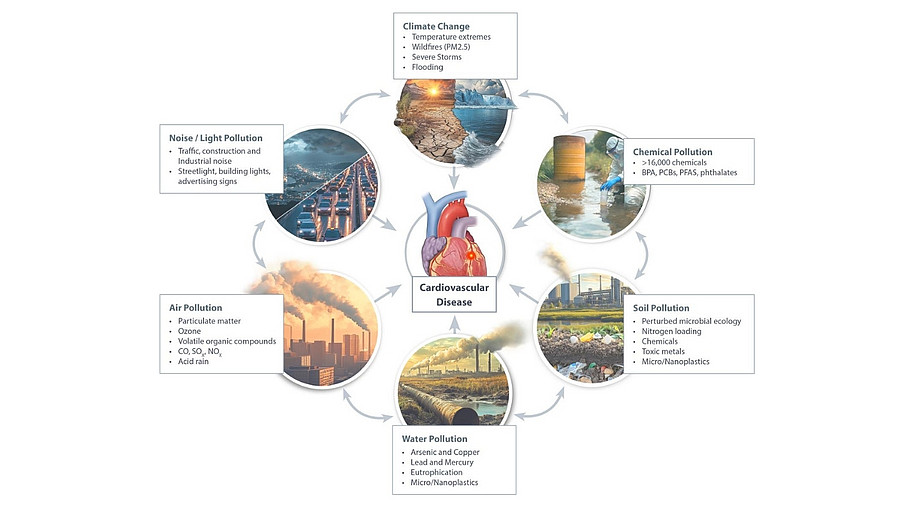Heart under stress: How noise, air pollution, heat and chemicals act together to damage the cardiovascular system
Environmental factors such as fine particulate matter, noise, heat, and toxic substances can significantly increase the risk of cardiovascular diseases, the leading cause of death worldwide. An international team of researchers reports this in a review article published today in Cardiovascular Research. The detrimental effects, according to the scientists, are particularly severe when multiple environmental stressors co-occur. The experts therefore emphasize that the combined influence of these exposures and their complex interactions – the so-called multimodal exposome – should play a central role in designing preventive measures.
Cardiovascular diseases comprise a broad range of disorders affecting the heart and blood vessels, including myocardial infarction, stroke, coronary artery disease (CAD), hypertension, heart failure, and arrhythmias. These conditions remain the number one cause of death worldwide. In Germany, they account for approximately 40% of all deaths, according to the Robert Koch Institute. Therefore, the demand for effective preventive strategies is substantial, and understanding the relevant risk factors is essential. Well-established contributors include obesity, diabetes, smoking, physical inactivity, and an unhealthy diet.
Environmental stressors impair cardiovascular health
An international research team involving the University Medical Center Mainz now warns in a comprehensive review about another group of risk factors that have thus far received limited attention in current prevention strategies: environmental stressors. The authors report in Cardiovascular Research that chronic exposure to noise, fine particulate matter, heatwaves, and chemical pollutants in soil and water can exert harmful effects on the cardiovascular system.
Key findings of the current publication:
- Chronic traffic noise activates stress hormone pathways, disrupts sleep, and induces hypertension and vascular inflammation.
- Air pollution, fine particulate matter, particularly ultrafine particles (PM₂.₅, UFP), can penetrate deep into the lungs, enter the bloodstream, and promote oxidative stress, endothelial injury, and atherosclerosis.
- Increasingly frequent heatwaves place particular strain on elderly individuals and those with pre-existing cardiovascular disease. In cities, impervious surfaces and lack of greenery exacerbate “heat island” effects, increasing the risk of myocardial infarction and stroke.
- Persistent chemical pollutants such as pesticides, heavy metals, and PFAS (per- and polyfluoroalkyl substances), which degrade slowly or not at all, can enter the body through food and drinking water. Early studies suggest they can enhance inflammation, impair vascular function, and elevate long-term cardiovascular risk.
Multimodal exposome amplifies health risks
Of particular concern is the combination of multiple environmental stressors: the multimodal exposome can magnify the detrimental effects of individual exposures. “Noise can intensify the impact of air pollutants, and heat can act as a catalyst for vascular damage caused by toxins,” explains Univ.-Prof. Dr. Thomas Münzel, Senior Professor at the Department of Cardiology – Cardiology I of the University Medical Center Mainz and one of the review’s authors. “The overlapping biological mechanisms range from oxidative stress and activation of the pro-inflammatory enzyme NOX-2 to endothelial dysfunction – all of which are early precursors of myocardial infarction and stroke,” adds Professor Münzel.
The exposome concept offers a holistic framework that integrates the lifetime accumulation of environmental exposures and their biological interactions into cardiovascular risk assessment, enabling the development of more targeted preventive strategies. The authors stress that stricter environmental and noise protection laws, sustainable urban planning, and green infrastructure can help reduce exposure to these stressors.
The international research team includes, alongside the Mainz authors (Thomas Münzel, Andreas Daiber, Marin Kuntic), leading environmental health and cardiology experts from Copenhagen, Denmark (Mette Sørensen), Munich, Germany (Alexandra Schneider), Barcelona, Spain (Mark Nieuwenhuijsen), Edinburgh, UK (Mark Miller), and Boston, USA (Philip Landrigan).
Original publication:
Münzel T, Kuntic M, Lelieveld J, Daiber A et al. A comprehensive review/expert statement on environmental risk factors of cardiovascular disease. Cardiovascular Research 2025.
Contact:
Univ.-Prof. Dr. Thomas Münzel
Department of Cardiology – Cardiology I
University Medical Center Mainz
phone +49 174 2189542
email
Press contact:
Veronika Wagner, M.A.
Corporate Communications
University Medical Center Mainz
phone +49 6131 17-8391
email
The University Medical Center of the Johannes Gutenberg University Mainz is the only medical institution of supra-maximum supply in the German state of Rhineland-Palatinate and an internationally recognized science location. Medical and scientific specialists at more than 60 clinics, institutes and departments work interdisciplinarily to treat around 403,000 patients per year. Highly specialized patient care, research and teaching are inseparably intertwined. Around 3,700 medicine and dentistry students as well as around 590 future medical, commercial and technical professionals are trained in Mainz. With a workforce of approximately 9,000 colleagues the University Medical Center Mainz is one of the largest employers in the region and an important driver of growth and innovation. Find more information online at www.unimedizin-mainz.de
[2024]
